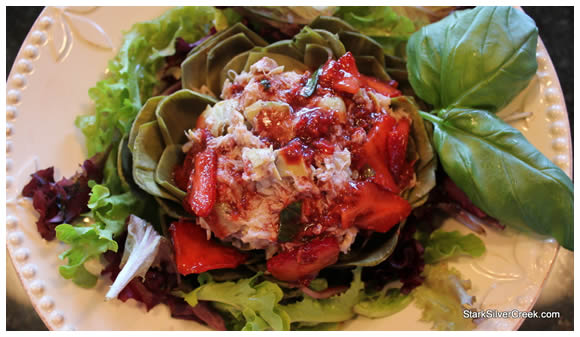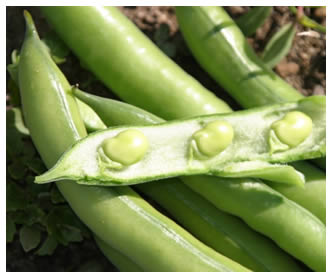Notes from Debbie's Kitchen~~~~~~~~~~~~~~~~~~~~~~~~~~~~~~~~~~~~~~~~~~~~~~~~
Click here to go to the recipe database.This week, everybody will be getting the young fava bean pods, so I'll talk about them again, below, in case you're new this week! The green garlic is still quite young yet, and as such, the flavor is milder than mature cloves of garlic. Don't be afraid to chop up and use an entire stalk (or two, if small) in place of a minced clove. We're getting carrots again too after a small hiatus (yay!); I've been missing having those crispy sweet babies in my fridge. We're still getting big beautiful leeks, and so I am putting in a braised leek recipe I found in the New York Times. But before I get to any of that, we have another member contribution, this time from Loni Kao Stark, who has a delightful blog, wherein recently she started blogging about what she makes with her weekly box of produce from the farm. Be sure to check it out. - DebbieLoni's "Play with your food" artichoke and crab salad with strawberry basil vinaigretteAs the weather in the Bay Area warms up, this recipe will transform your artichokes and strawberries in the latest Live Earth Farm shipment into the perfect light, refreshing lunch to be enjoyed with friends and a bottle of Riesling or Sauvignon Blanc.
 Main Salad
Main Salad- 4-5 artichokes (I used five since that was how many came with my shipment from Live Earth Farm)
- 16 oz. of fresh crab meat
- 1 1/2 tbsp. of mayonnaise
- 1 tsp. of Dijon mustard (I like the kind with whole mustard seeds in them)
- a pinch of grey/sea salt
- a pinch of freshly ground pepper
- some salad greens to dress up the plate
Strawberry Basil Vinaigrette- 10 strawberries
- 10 fresh basil leaves
- 2 tbsp. of extra virgin olive oil
- 2 tbsp. of aged balsamic vinegar (I like to use vinegar that has been aged at least 8 years)
- 1 tbsp. of freshly squeezed lemon juice
- a pinch of salt
Vinaigrette: Slice up the strawberries and fresh basil leaves. Put into a mortar and pestle. Add the olive oil, balsamic vinegar, lemon juice and salt. Pulverize until the strawberries and basil leaves have infused into the balsamic vinegar and olive oil.
Main Salad: Steam artichokes. Pull apart into flower shape. Scoop out hearts and chop up.
In a medium size bowl, add the crab meat, chopped artichoke hearts, mayonnaise, dijon mustard, salt, pepper, and 3 tablespoons of the strawberry vinaigrette. Mix thoroughly.
Plating: On a bed of lettuce, gently transfer the artichoke leaves so they maintain the flower shape. Place 1/4 of the artichoke crab mixture at the center of the leaves. Drizzle the vinaigrette on top. Add ground pepper if preferred.
For step-by-step instructions including beautiful pictures,
click here to go to Loni's blog.
Here's the leek recipe I was talking about. I looked this up because I just roasted my first chicken from Surfside Chickens last night (yum again!), and saved a jarful of pan drippings. Envisioning using those drippings with some white wine to braise a bunch of leeks (still have mine from last week), I went searching online for a promising recipe, and liked the sound of this one; I figured you'd all enjoy it too:Braised Leeks
from the NY Times, Nov 9, 2005
Adapted from "Sunday Suppers at Lucques"
Serves 6
Prep Time: 1 hour
15 minutes6 large leeks
Kosher salt and freshly ground black pepper
About 3/4 C extra virgin olive oil
1 C sliced shallots
1 tbsp. thyme leaves
1/2 C dry white wine
1 1/2 to 2 C chicken or vegetable stock
1. Preheat oven to 400
degrees.
2. Peel any bruised outer layers from leeks. Trim roots,
leaving root end intact. Trim off tops on diagonal, leaving two inches
of green. Cut in half lengthwise. Clean very well in water to remove
internal grit. Pat dry with towel.
3. With cut sides up, season with 2 teaspoons salt and a few
grindings of black pepper.
4. Heat pan over medium-high heat for 2
minutes. Pour in 1/4 cup oil and wait 1 minute. Place cut side down in
pan without crowding them. (Make in two batches, and use more oil, if
necessary.) Sear them 4 to 5 minutes, until golden brown. Season with
salt and pepper, and turn over to cook 3 to 4 minutes. Transfer them,
cut side up, to a gratin dish that will fit leeks and chicken, or use
two dishes.
5. Pour 1/4 cup oil into pan and heat over medium heat.
Add shallots, thyme, 1/4 teaspoon salt and a pinch of pepper. Cook about 5
minutes, until just beginning to color. Add wine and reduce by half.
Add 1 1/2 cups stock, and bring to a boil over high heat. [I think this is where I'd substitute my white wine and pan drippings, perhaps not reducing the wine, but instead using it to thin the drippings, since they are already, in essence, 'reduced'.]
6. Pour
over leeks, without quite covering them.
7. Braise in oven 30
minutes, until tender.
Young Fava Pods redux
The most important thing to remember about the favas you're receiving right now is that you don't need to shell them - you can cook and eat them pods and all! The beans inside are still immature (see picture, at left), and so by peeling and skinning them, not only are you wasting 90% of the veggie, but you're expending an extraordinary amount of time and effort to get a few tablespoons of pea-sized beans. The pods at this stage are still delicate and tender, like a fresh green bean. Whenver the pods are uniformly slender and bright green like they are now, this holds true. In the coming weeks, the pods will get MUCH larger, and the beans inside the pods will begin to swell and bulge obviously through the pod. As the beans get big, the pods begin to toughen.
That's when you want to start shelling and composting the pods and skinning and cooking the beans only.
Here are some basics on how to cook with young fava pods:
Cut them in segments, steam them about 5 minutes, until tender. From there, you can branch out --
<> chop up and saute up a bunch of green garlic; throw in steamed pod segments, sprinkle with salt, and cook a few minutes more so the garlic and fava flavors mingle. Serve as a veggie side, just like that.
<> do the same as above, and maybe add some fresh (or dried) herbs and some diced oil-cured sundried tomatoes, and toss with cooked pasta; cheese optional.
Or instead of steaming the pod segments, throw them into a soup and let them simmer for the last 10 minutes or so of soup-cooking time.
Or instead of either of those, leave the pods whole, coat them lightly with olive oil, sprinkle with salt (and optional herbs, or maybe crushed chilies or similar hot pepper if you like spice), and grill them a couple minutes on each side until brown grill marks appear and pods begin to soften. Then serve 'em up with a knife and fork, so you can cut into your own bite-sized pieces.
I encourage you to experiment! :-) Debbie
End note: I made a modified version of last week's Pasta with Mizuna with Walnuts for dinner tonight and wanted to pass it along, as I think it came out tasty!Mizuna with Bacon, Walnuts and Apple(note the lack of pasta - this is just a veggie side-dish. I served it with left-over roasted chicken)
serves 2 (generously) to 4 (in smaller portions)
1 to 2 bacon slices, diced (I used only one, but had to add some
additional fat from my bacon fat jar in the fridge)
half a small onion, chopped
3 or 4 small green garlic stalks, white
and light green part, sliced like scallions
1 apple, cored and diced
about 2 tbsp. cider vinegar instead of red wine vinegar (enhances the apple-y taste of the dish)
1 tbsp. Dijon mustard
about 1/4 C of walnut pieces (or coarsely
chopped walnuts)
juice from half a
small lemon
1 large bunch mizuna, washed and coarsely chopped
salt and pepper to taste
Cook bacon in skillet over medium heat until mostly browned; add onion and green garlic and continue to cook until bacon is done and onions and garlic are starting to brown as well. Add apples, stir and heat maybe another minute or so (adding more fat or some olive oil, if needed). Add cider vinegar, mustard, and walnuts, stir to distribute mustard. Add lemon juice, then mizuna, sprinkling with salt and pepper to taste. Stir and cook until mizuna is just wilted. Turn off heat and serve.